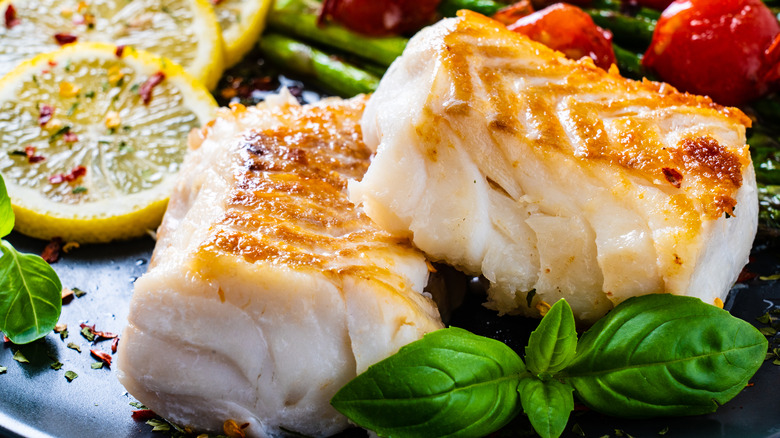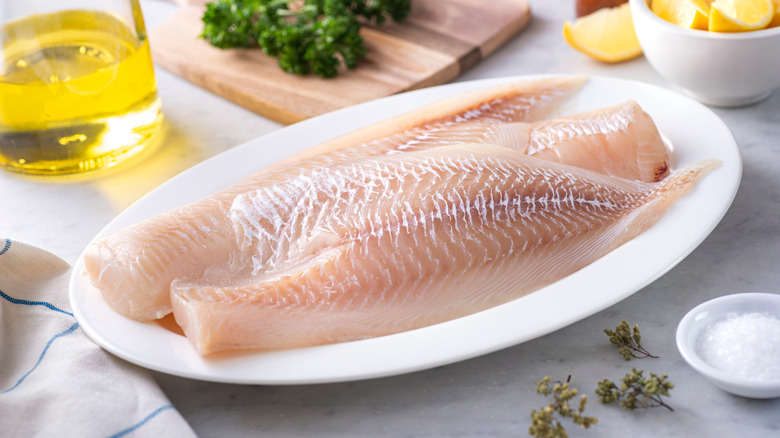Pollock Vs. Cod: What's The Difference?
When it comes to fish, people tend to get a bit picky. Some people prefer to pick fish like salmon and sea trout, while others prefer a white flakey texture instead. Fish is pretty divisive, you love it or avoid it like the plague, but ultimately fish is a pretty large source of protein around the world, making up about 20% of total animal protein consumed globally (via SF Gate). If you aren't afraid of a little fishy activity at the dinner table, you honestly should be incorporating seafood into your diet.
According to the American Heart Association, fish contains essential vitamins and minerals such as calcium, phosphorus, iron, zinc, iodine, magnesium, and potassium, and recommends consuming them twice a week in order to maintain a healthy diet. Two kinds of fish, which are all too often overlooked, but are just as good of a protein source as other swimmers, are the Pacific cod and Atlantic pollock. These two fish come from different seas, but they are more alike than many people know.
What is cod?
Cod, while perhaps not as famous as salmon or tuna, is still relatively popular. According to NOAA Fisheries, Pacific cod is the second largest commercial fish in America, and in 2021 alone, over 330 million pounds were harvested. The Marine Stewardship Council claims that cod fish has always been a big part of the European diet and that it is now enjoyed quite a bit by a larger global audience. The three major cod species, the Atlantic, Pacific, and Greenland, are recognized for their white flesh and moistness. Cod is also currently MSC-certified sustainable and is widely available, so if you're looking for a great environmentally-friendly fish, try shopping for cod.
Fishing Booker states that cod fish and pollock are both perfectly delicious white flaky meat, but cod is stronger in flavor and firmer in texture. Cod is delicious no matter how you cook it whether you prefer fish sticks or fish chowder it will hold up to the heat and lend a rich flavor, but something every cook should be aware of is that cod, like pollock, contains parasitic worms which are killed during the cooking process. You must never eat either fish raw and be sure it is thoroughly cooked before consuming.
What is pollock?
Southern Living describes Alaskan pollock as a species of cod. The family relationship is why pollock and cod have so many similar characteristics, such as white flaky flesh. Pollock also looks like a cod with a long, green body and a small chin reminiscent of other types of cod fish (via Britannica). Alaska pollock is not nearly as famous as other kinds of cod, in fact, Sutter Health claims that many people don't even know that they are consuming it though the fish is commonly served in restaurants, taquerias, and fast food lines.
Like cod, pollock is a respectable source of lean protein and is rich in vitamin B12, phosphorus, selenium, and omega 3 fat, though the benefits from eating this fish can be negative depending on how it's cooked. According to Ukrainian Importers of Fish and Seafood (UIFSA) Alaska pollock is fattier than Pacific cod and is inherently a bit softer, meaning that it has a more difficult time holding its shape while cooking and can fall apart. Izzy Cooking says that despite the fish's softer texture, pollock can be made in a variety of ways including baking, grilling, pan frying, and sauteing, and can be used in tacos, pasta, and even a summer salad. If you're looking to save money, pollock is also typically a cheaper alternative to cod, per Fishing Booker.


